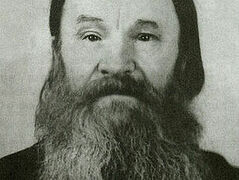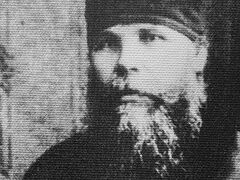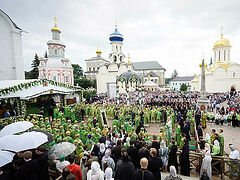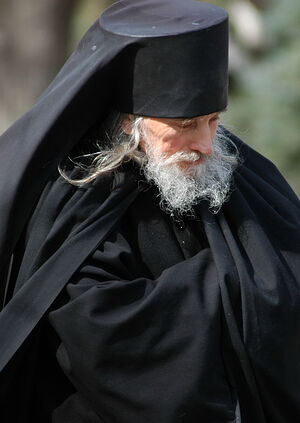 Schema-Igumen Damaskin. Photo taken in c. 2005 “Only prayer, silence and love are effective... It is better to turn to the hearts of other people through secret prayer than turn to their ears,” the Venerable Porphyrios of Kavsokalyvia said. This image of Schema–Igumen Damaskin was imprinted in the memory of the brethren of the Holy Trinity-St. Sergius Lavra. He was a silent man of prayer, always concentrated, quiet, loving solitude and living exclusively by the faith and love for God. According to the former Lavra abbot, Vladyka Theognost, faith kept Fr. Damaskin on this earth—it was his core and support, and the elder’s good stillness edified many.
Schema-Igumen Damaskin. Photo taken in c. 2005 “Only prayer, silence and love are effective... It is better to turn to the hearts of other people through secret prayer than turn to their ears,” the Venerable Porphyrios of Kavsokalyvia said. This image of Schema–Igumen Damaskin was imprinted in the memory of the brethren of the Holy Trinity-St. Sergius Lavra. He was a silent man of prayer, always concentrated, quiet, loving solitude and living exclusively by the faith and love for God. According to the former Lavra abbot, Vladyka Theognost, faith kept Fr. Damaskin on this earth—it was his core and support, and the elder’s good stillness edified many.
Schema-Igumen Damaskin (secular name: Pyotr Nikolaevich Krasnykh) was born on July 8, 1925 in the village of Putyatino in the Dobroye district of the Lipetsk region, to a family of workers.
He finished seven grades of secondary school in Losino-Petrovsky near Moscow and in 1942 entered a vocational school. After graduating from it in 1945, he was sent as a metalworker to a factory in the town of Kaliningrad near Moscow (in 1996 Kaliningrad was renamed Korolev).
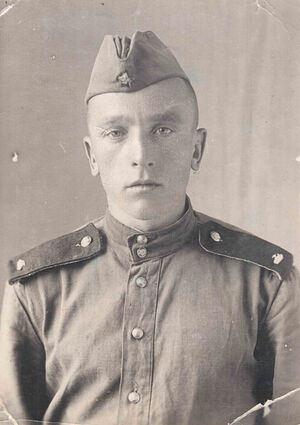 Private Pyotr Krasnykh during military training, around 1955 From 1948 to 1960 he worked at the Monino plant (Moscow region), first as a metalworker of the fifth class, and then, after studying at the Factory training school (1954–1956)—as a weaving manager assistant. During this period he underwent ninety-day military training with the rank of private.
Private Pyotr Krasnykh during military training, around 1955 From 1948 to 1960 he worked at the Monino plant (Moscow region), first as a metalworker of the fifth class, and then, after studying at the Factory training school (1954–1956)—as a weaving manager assistant. During this period he underwent ninety-day military training with the rank of private.
In October 1960 he entered the Holy Trinity-St. Sergius Lavra as a novice and was a monk there for over fifty years.
On July 11, 1964, Novice Peter submitted a request to the father-superior for the monastic tonsure with the words:
“I ask for your intercession with His Holiness Patriarch Alexei I for my monastic tonsure. I promise to perform my obedience at the Monastery of St. Sergius until the end of my earthly life.”
On July 21, 1964, he was tonsured into the mantia with the name Procopius (Prokopy). The monastic tonsure was performed by the Lavra abbot, Archimandrite Pimen (Khmelevsky).
On October 9, 1964, at the Dormition Cathedral of the Holy Trinity-St. Sergius Lavra, with the blessing of His Holiness Patriarch Alexei I, he was ordained a hierodeacon by Archbishop Leonid of Perm and Solikamsk; on January 31, 1966, at the refectory church of the Lavra, Bishop Irinei (Zuzemil) of Munich ordained him hieromonk; in 1973, on the feast of Holy Pascha, he was elevated to the rank of igumen.
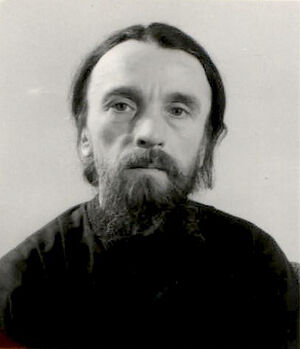 Novice Peter Krasnykh On April 15, 1979, he was tonsured into the Great schema. The tonsure was performed by the Lavra abbot, Archimandrite Ieronim (Zinoviev). The sponsor at the tonsure was Archimandrite Kirill (Pavlov), the father-confessor to the brethren.
Novice Peter Krasnykh On April 15, 1979, he was tonsured into the Great schema. The tonsure was performed by the Lavra abbot, Archimandrite Ieronim (Zinoviev). The sponsor at the tonsure was Archimandrite Kirill (Pavlov), the father-confessor to the brethren.
Fr. Damaskin was a schemamonk by vocation. He never boasted of his schema and did not even always wear it, preferring to wrap himself into his mantle, curled up like a ball.
The elder was known for strict abstinence in everything—in food, sleep and words. At the refectory he ate very little, and in his cell you could see only a piece of white bread and a mug of tea, which he would take at the refectory in the morning and drink in the afternoon, heating up this tea on his little electric stove. Fr. Damaskin always had a canister of spring water in his cell. When the water ran out, he would take a bus to the village of Glinkovo near Sergiyev Posad to fill another canister, saying that that water contained a lot of silver. Batiushka slept very little and never lay in bed. In his cell he had an armchair, in which his slept. Because of this the elder’s legs were swollen, and he walked with difficulty. Icon lamps burned perpetually in front of the icons in his cell; Fr. Damaskin loved solitude and nighttime prayer. At three in the morning, he usually began reading his private monastic rule. Every day he went to all the services in the morning and in the evening. Due to lack of sleep he sometimes became utterly exhausted and would fall asleep right during services. Once there was a funny story because of this. During the evening service at the refectory church Fr. Damaskin fell asleep. The reader did not notice him and after the service, before going home, he as usual locked the sanctuary and the church. Fr. Damaskin woke up and saw that the sanctuary was locked. Fortunately, there was a phone there. Batiushka called the deputy abbot and asked him to “let him out”. The reader had to go back.
Fr. Damaskin was so deep in prayer that he could walk throughout the Lavra without being distracted by anything, without answering any requests, without even greeting anyone. Sometimes it looked very odd.
Igumen Philaret (Tambovsky), a cleric of the Church of the Icon of the Mother of God, “Joy of All Who Sorrow” in Bolshaya Ordynka Street in Moscow, who had known the elder closely for many years, once asked Elder Kirill:
“Why does Father Damaskin pass by lost in thought without blessing or answering? Maybe he is offended?”
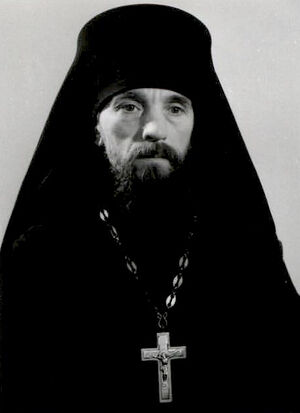 Hieromonk Procopius (Krasnykh) Fr. Kirill replied, “What are you saying! The schemamonk is praying unceasingly. It’s spiritual life—you should understand this.”
Hieromonk Procopius (Krasnykh) Fr. Kirill replied, “What are you saying! The schemamonk is praying unceasingly. It’s spiritual life—you should understand this.”
Igumen Philaret confessed his sins to Fr. Damaskin for many years. Every time at the end of the confession Fr. Damaskin would ask his name. Fr. Philaret thought, “Can’t he remember my name after so many years? He remembers the names of the Lavra brethren.”
The next time Fr. Philaret came to the Lavra for Pascha and when he went up to Fr. Damaskin, he gave him an egg and said, “Christ is Risen! Father Philaret, I always remember you and pray for you.” He smiled meekly, bent over and walked away. He never laughed—he was strict, like St. Basil the Great.
Fr. Philaret related how Fr. Damaskin miraculously helped him in 2004. Then the elder said to him, “The place where you currently perform your obedience is bad for you. Check your blood pressure—you have ‘hidden high blood pressure’. But don’t be upset: trust entirely in the Mother of God. Things will be sorted out in less than a year.”
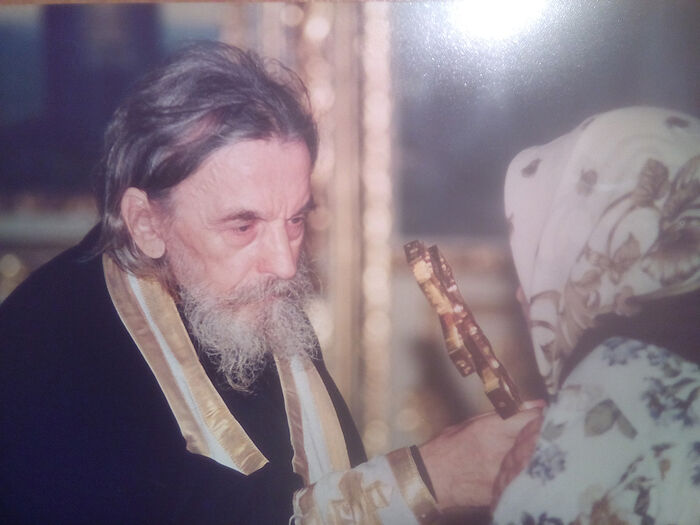 At confession at the Church of the Exaltation of the Cross in the village of Troitskoye
At confession at the Church of the Exaltation of the Cross in the village of Troitskoye
Indeed, soon Fr. Philaret had a hypertension stroke, and after some time he was transferred to Moscow, to the church in Bolshaya Ordynka.
When Fr. Damaskin was younger, he used to travel extensively in Russia. Those trips reflected the elder’s concern and prayers for the whole world. Batiushka had many spiritual children in the south of Russia and in the Moscow region who loved him dearly and waited for him. This was a certain paradox of the elder’s personality—it was difficult for rational-minded people to get on with him, while the hearts of simple, emotional old women were closer to him.
Being silent and detached from the world at the Lavra, alongside pious old women Fr. Damaskin seemed to be transformed—they prayed and prepared for Communion together... There, in the provinces, batiushka’s love for the whole world and his spiritual children was felt very keenly.
One day, Fr. Damaskin came to stay at a skete in the south of Russia. Pilgrims did not come there—it was a tiny “skete-church”, surrounded by a high fence, with a few monks. During a walk, the elder, passing by an apple tree under which there were many fallen apples, wondered, “So many apples! Why is no one picking them up?” And he added with a special intonation (he rarely spoke that way-with emphasis on words, categorically), “After all, we must pray and work!”
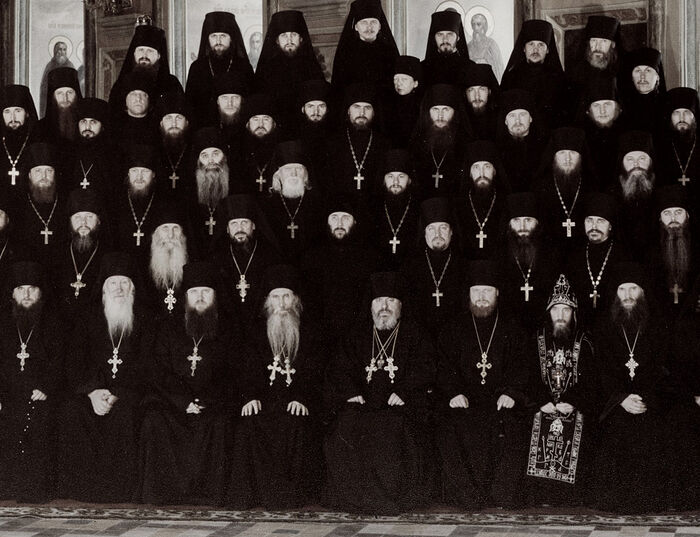 Fr. Damaskin among the Lavra brethren (second from the right in the lower row)
Fr. Damaskin among the Lavra brethren (second from the right in the lower row)
According to the reminiscences of the abbot of the Kozheozersky Monastery of the Theophany, Hieromonk Mikhei (Razinkov), Schema-Igumen Damaskin led an ascetic life, and the Lord gave him both spiritual and physical strength. When Fr. Mikhei lived with his brethren in Kotovo on the shore of the White Sea—very far from the nearest village—Fr. Damaskin came there seven times and supported the northern monastery’s monks.
“He walked all the roads, and it is dozens of miles,” Fr. Mikhei recalls. “He and I lived in the same cell. He slept only three hours a day. He always read the Gospel, always prayed with prayer ropes, attended services and ate very little. When we were attacked by temptations, he would say, ‘You should pray, fast and totally abstain from food for at least a day or two.’ And he set a good example in everything. He brought with him the book, The Flower Garden, by Monk Dorotheus, which became a manual for all the brethren. He didn’t talk much, but with his silence your heart didn’t feel heavy, but rather at ease. That’s how I remember him—as a silent man of prayer.”
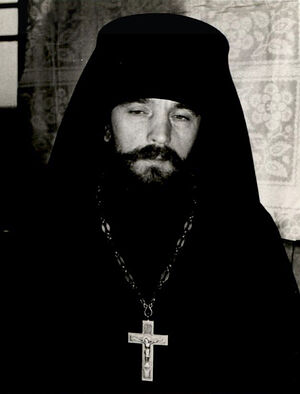 Abbot Procopius (Krasnykh) The laconic Fr. Damaskin set an example to the brethren. According to his cell-attendant, the elder could sit for half a day with a book in his hands in the presence of several people without saying a word.
Abbot Procopius (Krasnykh) The laconic Fr. Damaskin set an example to the brethren. According to his cell-attendant, the elder could sit for half a day with a book in his hands in the presence of several people without saying a word.
Igumen Vsevolod recalls:
“Father Damaskin was very quiet and inconspicuous. He would answer your question briefly and run away. He ate very little and served strictly and reverently. He always attended the common evening prayer rule, which was read at the refectory after dinner.”
The Lavra’s Hierodeacon Sophrony also often attended this prayer rule, and Igumen Philip shared his recollections of one remarkable episode to which he had been an eyewitness during the rule. Fr. Sophrony was known for his difficult character, even feigned foolishness. He was reputedly clairvoyant—at least after his death the brethren discovered many of secret the elder’s secret ascetic labors, which they had not previously suspected.
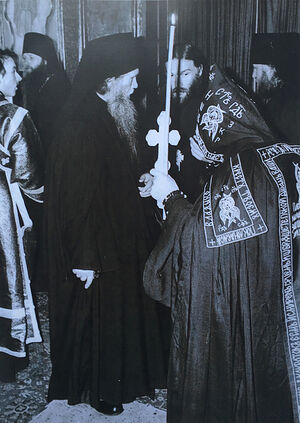 After being tonsured into the Great Schema, with Archimandrites Kirill and Bartholomew, 1979 At the evening rule, Fr. Sophrony usually didn’t look at the icons but rather at the reader—he stared intently, as the brothers used to say jokingly, “straight into your mouth”, and occasionally he averted his gaze and looked at the others. One day he looked like that at Fr. Damaskin, who was standing and listening to the rule. Suddenly Fr. Sophrony’s face changed, and as if looking into the space around the schema-igumen, he uttered with deep feeling, “You—my brother!” His face reflected amazement and shock… After being silent for a while, he could only repeat again, “You—my brother!...” We can only guess what was revealed at that moment to one ascetic about the spiritual life of another…
After being tonsured into the Great Schema, with Archimandrites Kirill and Bartholomew, 1979 At the evening rule, Fr. Sophrony usually didn’t look at the icons but rather at the reader—he stared intently, as the brothers used to say jokingly, “straight into your mouth”, and occasionally he averted his gaze and looked at the others. One day he looked like that at Fr. Damaskin, who was standing and listening to the rule. Suddenly Fr. Sophrony’s face changed, and as if looking into the space around the schema-igumen, he uttered with deep feeling, “You—my brother!” His face reflected amazement and shock… After being silent for a while, he could only repeat again, “You—my brother!...” We can only guess what was revealed at that moment to one ascetic about the spiritual life of another…
Schema-Igumen Damaskin’s cell attendant shared his first impressions of the elder:
“At first, he seemed strange and mysterious to me. He hardly ever spoke, was a little hunched over and always looked down. If he said something, it was in a strange manner, disconnected and very incomprehensible, even when he pronounced words carefully. Only occasionally did he lift his face to see someone who aroused his interest. Then you could see his very unusual, very lively and intelligent eyes. Later, when I started taking care of him in the Lavra, I saw him somewhat differently—more open and natural.”
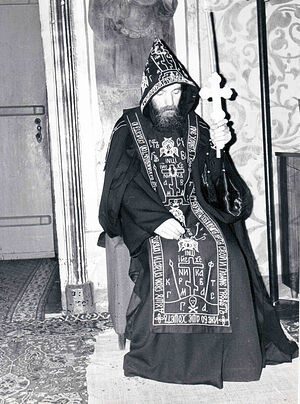 After being tonsured into the Great schema in the altar of the refectory church, 1979 In terms of spiritual guidance the elder did not give categorical blessings. “You go here, and you go there.” but he often asked leading questions, so it was hard to understand what he meant. You would have to look for answers yourself... At the same time, it was very difficult to live with the elder. You had to get his blessing for everything, and what you did willfully, even if “out of love”, could be punished.
After being tonsured into the Great schema in the altar of the refectory church, 1979 In terms of spiritual guidance the elder did not give categorical blessings. “You go here, and you go there.” but he often asked leading questions, so it was hard to understand what he meant. You would have to look for answers yourself... At the same time, it was very difficult to live with the elder. You had to get his blessing for everything, and what you did willfully, even if “out of love”, could be punished.
“One day I was so tired of such a life with him that I decided to flee to America—to ROCOR, to some Mission,” Fr. Damaskin’s cell-attendant recalled. “I prayed at the relics in the evening, explained everything to St. Sergius in my mind, and came back to batiushka in the cell (war is war, but I must put the elder to sleep every night). He said to me from the doorstep, ‘Are we going to America? Take me with you—I’ll be useful there...’ Another time, when it seemed I couldn’t bear it anymore and was about to leave, I put my things into a backpack and went to the utility room to deliberate on the situation there and move somewhere. When I passed the bridge behind the “publishing” tower of the Lavra, I suddenly felt really bad: my legs gave way and I had to go back.
“Once I woke up with a clear sense of anxiety and ran upstairs to the elder (I still slept in the cell for novices downstairs at that time) to find that the entire floor was filled with smoke. It was about four in the morning. I went up to the entrance to his cell and saw his electric kettle burning on a chair and batiushka standing in the doorway and praying with a prayer rope: ‘Our Father...’ All the veins on his face were bulging. I pulled out the cord and filled the kettle with water. It was a clear miracle: five minutes later the fire would have spread to the wooden cabinet and the chipboard walls, and everything would have caught fire very quickly. Everything was old there: the cell was narrow, the doorway was eighty centimeters wide, with a wooden chair and an old plywood cabinet next to it.”
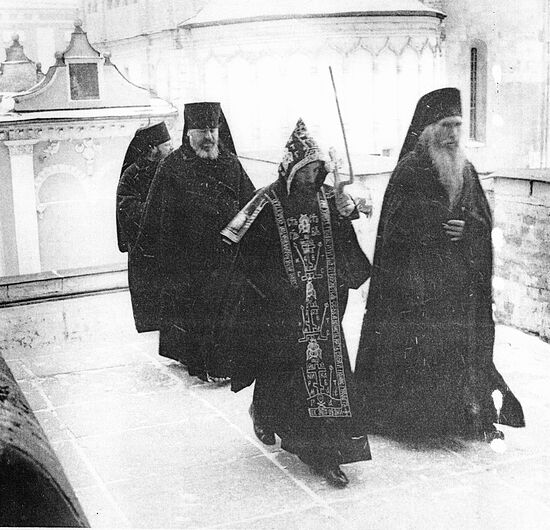 After being tonsured into the great schema. The covered arcade of the refectory church. Archimandrite Kirill is on the far right. The Lavra Abbot, Archimandrite Ieronim, is next after Fr. Damaskin
After being tonsured into the great schema. The covered arcade of the refectory church. Archimandrite Kirill is on the far right. The Lavra Abbot, Archimandrite Ieronim, is next after Fr. Damaskin
The windows were leaky, and it was very cold in the elder’s cell in winter. Fr. Damaskin used to feed pigeons through the window, often looking at the Lavra churches for a long time.
“When I glued up a crack in the window, it became a little warmer in the cell—about sixteen or seventeen degrees,” the cell-attendant related. “No wonder that in winter batiushka often fell ill. But he did not like being in hospitals, and as far as I remember, he never went to one. Batiushka never asked for anything at all.”
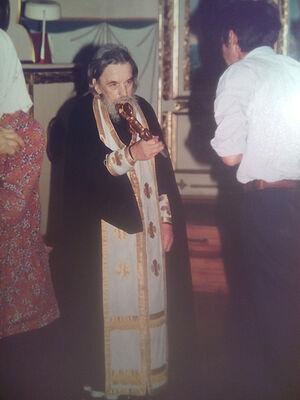 Igumen Damaskin with a parishioner at the Church of the Exaltation of the Cross in the village of Troitskoye (the Rostov region) The elder had a difficult childhood and youth—he lived through the famine. Once he mentioned that he had spent a long time in the cellar without food, hiding from German bombs. This experience hardened the elder: he would often go to services in winter in the cold, wearing only a cassock or ryassa over his underclothes, walking down the street in the cold. After not eating a for a whole day he would feel hungry, but he did not become weak and retained the ability to pray and read the canons.
Igumen Damaskin with a parishioner at the Church of the Exaltation of the Cross in the village of Troitskoye (the Rostov region) The elder had a difficult childhood and youth—he lived through the famine. Once he mentioned that he had spent a long time in the cellar without food, hiding from German bombs. This experience hardened the elder: he would often go to services in winter in the cold, wearing only a cassock or ryassa over his underclothes, walking down the street in the cold. After not eating a for a whole day he would feel hungry, but he did not become weak and retained the ability to pray and read the canons.
When he was younger, he would read a lot of Patristic works and write out some quotations or whole passages into his notebooks. He had plenty of such small notebooks.
Fr. Damaskin avoided speaking with people of a non-peaceful disposition. Whenever someone started arguing, he immediately left. The elder was very concerned about the spiritual state of the world and prayed incessantly. When he lived in Peredelkino with Archimandrite Mikhail (Balayev), they even painted over their windows so as not to be distracted from prayer.
Love for prayer and services was characteristic of Fr. Damaskin. In one of his sermons the Lavra abbot, Bishop Theognost, once said, “We have some feeble monks who do not miss a single common service of intercession the whole year.” These words were about Fr. Damaskin. The brethren were surprised at how he was always at church, even though he was so weak that he was about to fall apart.
“Every day I would wake batiushka up at about five in the morning, help him get dressed, and we would go to the brother’s moleben,” the elder’s cell-attendant recalled. “He always stood in front of the solea, despite his infirmity. In the final year of his life, he began to stand and sit down in the stasidia. At the end everyone would kiss the cross in the hands of the father-superior and venerate St. Sergius’ relics, and the brethren would go off to the churches and their obediences. Batiushka would stay for the Liturgy.”
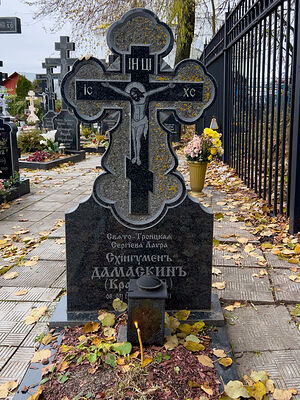 Schema-Igumen Damaskin’s grave at the monastic cemetery in Deulino Several times in the winter, in the sparkling frost, the elder, who was already eighty-five, fell on the steps of the Dormition Cathedral, but each time he rose and went on to the service... It was his principled position not to miss a single service. Only during his final illness was Fr. Damaskin unable attend the moleben, midnight office, and Liturgy that followed. Nevertheless, his love for the Church was so great that even on the day of his repose his cell-attendant asked if he would go to the common service of intercession.
Schema-Igumen Damaskin’s grave at the monastic cemetery in Deulino Several times in the winter, in the sparkling frost, the elder, who was already eighty-five, fell on the steps of the Dormition Cathedral, but each time he rose and went on to the service... It was his principled position not to miss a single service. Only during his final illness was Fr. Damaskin unable attend the moleben, midnight office, and Liturgy that followed. Nevertheless, his love for the Church was so great that even on the day of his repose his cell-attendant asked if he would go to the common service of intercession.
He reposed at the Lavra, in his cell in the St. Barbara’s living quarters, early in the morning during the brother’s moleben to St. Sergius, having fulfilled his promise to struggle at the Monastery of St. Sergius to the end of his earthly life. Many people remembered the date of the elder’s repose: It was impossible not to remember it—November 11, 2011—the eleventh day of the eleventh month of the eleventh year.
After the vesting and the litany in the cell, the brethren together brought the newly departed elder to the Church of the Descent of the Holy Spirit on the Apostles, where the Gospel was read unceasingly at the coffin. The funeral service for Fr. Damaskin was performed by the then Lavra Abbot, Bishop Theognost, with the brethren concelebrating, after the memorial Liturgy at the Dormition Cathedral.
The ever-memorable Schema-Igumen Damaskin was buried in the monastic cemetery at the Church of the All-Merciful Savior in the village of Deulino.

